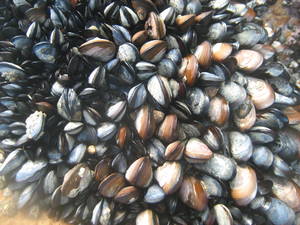A super-strong glue-like substance capable of repairing ships and  even sealing up surgical wounds, has been made from mussels by US scientists.
even sealing up surgical wounds, has been made from mussels by US scientists.
The researchers, based at MIT and led by Timothy Lu, were inspired by the way mussels stick resolutely to rocks and other surfaces. They do this using a muscular fleshy foot coupled with secretions of sticky foot proteins that act as an anchor.
To create their underwater adhesive, the MIT researchers first identified the genes responsible for the foot proteins in the mussels and then engineered them into Escherichia coli (E. coli) bacteria. Additionally, the DNA encoding curli fibres from bacteria were also inserted. Curli fibres are finger-like projections that extend from the bacteria's surface, helping them to attach to other cells or aiding biofilm production. Biofilms are slimy layers, which are often found on our teeth when we haven't brushed them properly.
Timothy Lu, the senior author of the paper published in Nature Nanotechnology, describes the engineered E. coli as "miniature living factories," from which the glue-like substance can be extracted.
To test the sticking power of the new material, the team used an atomic force microscope to measure the how well the glue adhered to a surface before detaching.And while it has not yet been possible to compare the adhesive to glue you might pick up at the supermarket, according to Lu, it is the "strongest biologically inspired, protein-based underwater adhesive reported to date." They plan to soon test it against known-brands such as superglue.
Remarkably, the material also works underwater, meaning that its unparalleled strength means it could be useful in patching ships' hulls and other marine equipment. It could also be used in a medical setting, sticking tissues together post-op, although the safety and biocompatibility of the substance still needs to be explored.
Aligned with this, is the development of a 'living glue'. This is where a film of bacteria could be applied to a damaged surface, where upon they would start production of the adhesive, and subsequently repair the surface. Essentially they would act as miniature repairmen, who sense what the problem is and then deploy their tools in order to fix it.
Moreover, at the moment the new glue can only be produced in very small quantities which are far too small to be useful on an industrial-scale. "We wanted to first verify that the materials had the desired properties" Professor Lu comments, "but the next step for future research is to scale this process up, in order to make practical amounts."










Comments
Add a comment